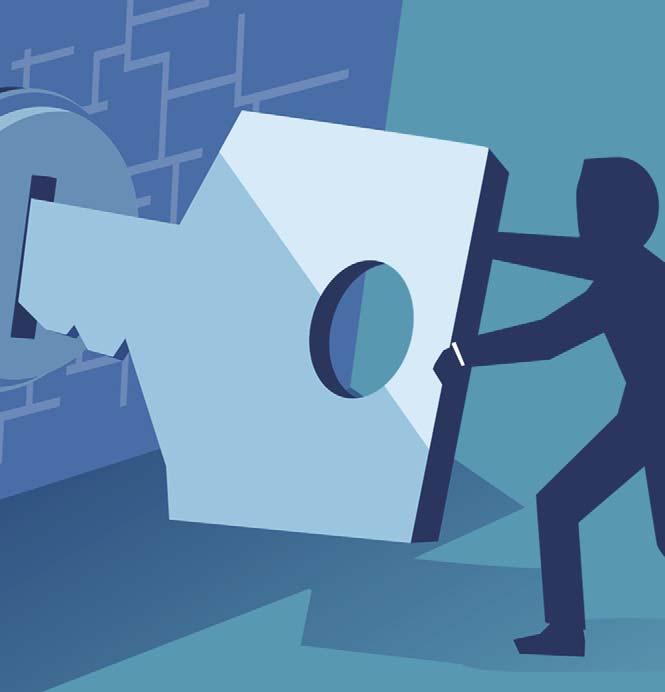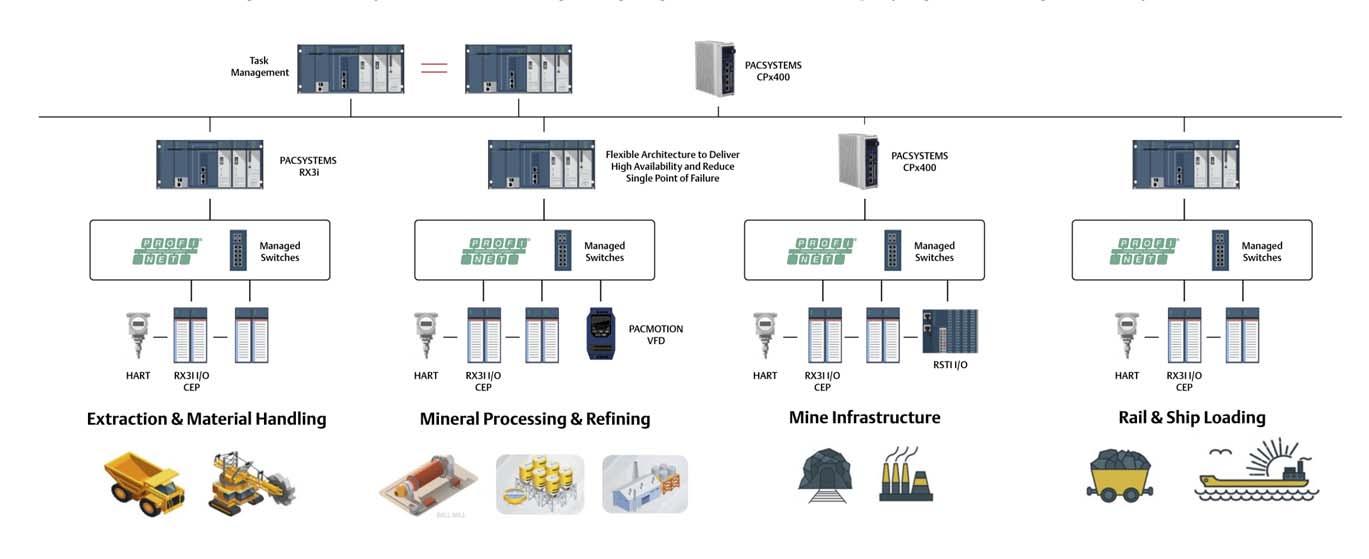
8 minute read
Accessing Intelligent Data
Thishen Naidoo, Emerson, Canada, explains how implementing modern control system architectures and communications can help mining companies improve effi ciency and future-proof operations.

In the wake of the COVID-19 pandemic, the world of work continues to undergo crucial transformations. The shift can be considered somewhat seamless for certain sectors, such as technology workers. Traditional industries such as mining, on the other hand, operate massive and distributed assets, and are slower to move due to requirements for on-site workers. However, even here, the industry is working to gain productivity.
Mining companies have had to evaluate the sustainability of their current operating models, and this has necessitated a renewed focus on automation, along with the evaluation of remote operations technologies to improve adaptation during




challenging times. Better data connectivity and analysis lead immediately to improved operational uptime and asset utilisation. These technologies also pave the way for the adoption of autonomous mining methods, which will surely accelerate for operations everywhere.
Intelligent data access depends on several fundamentals, including: Reliable methods of connecting with field-located source data. Low-latency preprocessing at the edge to streamline data flows. Analytical and asset management systems taking advantage of the previous two points to provide the right intelligence at the right time.
Whether mining operators are installing new projects or upgrading existing assets, there are many automation technology options which can be implemented to provide intelligent data access to improve the availability and maintainability of production systems.
Tackling remote challenges
Many production facilities are large and distributed over wide geographic areas. Mining operators contend with both these issues, as well as a general lack of power and communication infrastructure. Operations and maintenance personnel usually work out of a central location, making it diff icult but important to detect remote operational issues, and to address them eff iciently.
Deploying personnel at the right time, with the necessary skill sets and supplies, is a top priority to prevent or resolve issues. At older sites, the staff may have been largely on the move, looking for trouble and communicating by radio back to a main location.
Applying newer technologies enables mining operations to establish a much more capable remote operating centre (ROC). This is not a new concept in itself, but what is new is the vastly improved visibility and insights made possible by access to processing and asset data. The scale and capabilities of ROCs vary. In Australia, for example, several companies have adopted the ROC model, consolidating several streams of real-time data from diff erent sites to improve daily decisions.
An ROC naturally makes sense for widely distributed sites, but it demands computing devices, networking, and certain infrastructure support. Furthermore, it is not enough to simply capture and transmit vast amounts of data if it is not available in context. Data is only powerful and actionable when matched with a good predictive maintenance strategy to avoid stoppages, with analysis to optimise equipment and systems. These users need solid and scalable methods of transferring high data volumes from mine sites to the ROC, where staff can analyse this data to maximise machine uptime and asset utilisation.
Architecting for success
Industrial automation technologies have traditionally been used for direct control and are designed to withstand the harsh environments common to mining sites. In recent years, advances in computational and communication capabilities have enabled these automation elements to play a much larger – and, in fact, preferred – role when it comes to accessing data.
An ROC needs to consolidate several streams of real-time data generated at various sites – including direct operational data – along with equipment condition monitoring signals, such as: motor temperatures, vibrations, and energy consumption. By using this and other inputs, with all values gathered in appropriate context with each other, a mining organisation can optimise production and coordinate logistics, supply chains, and maintenance activities.
Much of the success and overall productivity gains from the ROC model is contingent on the integrity of plant hardware, sensors, and instrumentation which feed data back to the ROC to be processed and analysed. In addition to the real-time data streams, it is important to gather diagnostic and integrity information from thousands of field devices, so that each one can be proactively maintained to preserve overall productivity.

Figure 1. A mining site's automation architecture can deliver high availability and comprehensive data communications when it is architected with modern programmable logic controllers (PLCs) and edge controllers, such as Emerson’s PACSystems RX3i and CPx400 series. This architecture uses PROFIBUS fieldbus rings for field signal connectivity, and OPC UA over Ethernet for communications with upstream computing assets.
A comprehensive automation solution architecture must address user needs at three distinct levels (Figure 1): Input/output (I/O), fieldbus, and HART connectivity to field devices. Edge computing and communication capability. Process and asset analytics and management functionality.
Structuring an architecture in this way meets several control and data acquisition needs. Edge-located controllers can be installed as simplex units, one per equipment train, so that each train can operate independently and in parallel with others, in order to reduce any single points of failure. Where there are single points of failure associated with a controller, users can choose modern programmable logic controllers (PLCs) or edge controllers off ering easy-to-implement ‘check box’ redundancy.
Fieldbus installations are oft en susceptible to physical damage, due to their location and routing, so it is recommended for users to choose protocols capable of operating in a self-healing ring configuration. Designing an architecture in this manner maximises availability, while reducing the overall project hardware cost and the future need to carry spares.

At the fi eld, the edge, and the ROC
Traditional I/O is suff icient for basic signals, but many instruments are available in fieldbus or HART-capable configurations for transmitting extended information. Fieldbus devices natively send and receive many values instead of just one process signal, while HART is an industry-standard protocol for sending and receiving digital information over analogue 4-20mA signal wiring. These approaches can supply more advanced information, but only if the supervisory controller is capable of accessing or passing-through this data.
HART passthrough is attractive in many cases, especially for retrofits but also in new installations, because the HART information can be used by supervisory systems and handheld maintenance communicators with no extra controller configuration involved. This technology leverages standard or existing two-conductor shielded wiring, enabling a smart instrument to interact directly with the controller, so that users can proactively configure and manage the field device. However, to avoid more complex installations, it is important that controllers and I/O modules are designed to provide HART passthrough to supervisory systems. Before it was possible or cost-eff ective to deploy computing hardware at the edge, the only choice was to transfer large amounts of data to central computing resources, using signaling and networking burdened by the task. Modern PLCs, and an even newer category of edge controllers, are much better at communications and computations (Figure 2).
CHANGE YOUR MINE. THE RISE OF CONTINUOUS SURFACE MINING
It’s called: continuous surface mining. Using a machine like the
Vermeer Terrain Leveler® surface excavation machine (SEM) to perform continuous mining allows you to methodically mine or prep a site layer by layer — optimizing productivity and precision while eliminating many of the safety challenges and restrictions associated with drilling and blasting. Visit vermeer.com/changeyourmine to learn more.
Edge controllers natively work with operational technology (OT) protocols, such as PROFIBUS and HART, which are required to access field devices, as well as with information technology (IT) protocols, such as OPC UA and MQTT, required for connecting to higher-level resources. These controllers provide high-performance access to field signals, and they can be used to pre-process the low-latency field-sourced data as needed, minimising the required upstream data volume.
Once the data is transmitted to ROC computing assets, and perhaps on to cloud resources, is when end users can really begin to obtain value (Figure 3). Supervisory control and data acquisition (SCADA) systems, or other dedicated analytical soft ware, can be used to baseline and track operational performance, providing a tool for engineers and operators to optimise control functions.
Like many large processing industries, mining operations use many instruments, valves, pumps, and motor controls. With the right instrumentation and edge computing, all these devices can transmit valuable machine health monitoring information to a supervisory asset management system (AMS). With HART instruments, HART-enabled I/O modules, and HART-capable controllers and supervisory soft ware, this source data flows directly to the AMS soft ware. Users can ensure instrument calibrations are up to date, confirm instruments and valves are healthy (not plugged or wearing), and proactively identify issues so they can order replacements and plan shutdowns.

Figure 2. Emerson PACSystems RX3i CPE330 PLCs and CPL410 edge controllers are readily implemented as redundant pairs, and provide deterministic control in conjunction with secure data processing.
Figure 3. Redundant architectures and communications reliably transport mining operational data to the remote operating centre (ROC) and the cloud, where it can be visualised and analysed to maximise uptime, asset utilisation, and eff iciency.
Future-ready
By implementing modern control technologies, either as new projects or retrofits, mining companies will gain immediate benefits, while future-proofing operations. Deploying complementary field instruments, communication protocols, and controllers in this manner is necessary to enable process optimisation and asset management eff orts most eff ectively.
Today, these methods allow mining companies to establish one or more centralised ROCs, so their experts can eff iciently work on, or be deployed to, operations anywhere. Experts located anywhere in the world can be leveraged to work closely with local personnel, supporting many remote sites and supplementing onsite maintenance expertise.
Moving forward, mining companies can scale-up and add assets at one site, or they can consolidate information from a fleet of assets across many sites to gain insights. Soon, even more advanced capabilities, such as augmented reality, will also be a commonplace part of remote access and connectivity, enabled by automation systems available today.











